For the first time in sporting history, the world rugby’s showpiece tournament will be held in Japan. From the 20th of September to the 2nd of November, 20 of the world rugby’s superpowers will battle it out for the ultimate prize in rugby union – the Rugby World Cup.
For travellers and rugby fans making their way to the Land of the Rising Sun for this epic sports spectacle, we’ve put together a comprehensive guide that covers everything you need to know about each of the twelve stadia and the host cities. We’ll start off with the northern reaches of Japan in the province of Hokkaido and move down all the way to Kyushu in the south, covering each stadium, how to get there, and nearby attractions.
Hokkaido, Tohoku and Tokyo
1. Sapporo Dome
Stadium capacity: 41,410
Notable matches: England vs. Tonga, Sunday 22 September
How to get there: Fukuzumi Station is your jump-off point if you’re looking for easy access to the Sapporo Dome. It only takes about 10 minutes by foot from the station, located on the Toho Subway Line.
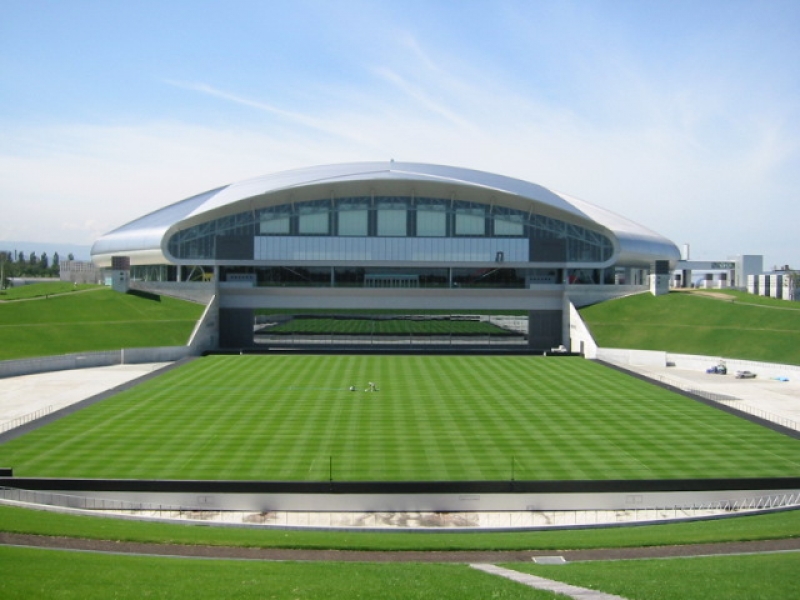
Image credit: もんもん
The capital of Hokkaido is no newcomer to hosting sporting events, with the Sapporo a host city for both the Olympic Winter Games in 1972 and more recently, the 2002 FIFA World Cup. Famed for its ice sculptures, skiing and beer, there isn’t any shortage of attractions for avid sporting tourists here.
2. Kamaishi Recovery Memorial Stadium (Kamaishi Unosumai Stadium)
Stadium capacity: 16,187
Notable matches: Fiji vs Uruguay, Wednesday 25 September
How to get there: Kamaishi is accessible by rail, plane and road, with flights into Iwate Hanamaki Airport. The station closest to the stadium is Unosumai Station, a 5-minute walk away. It’s around 5.5 hours from Tokyo, using the Tohoku-Hokkaido Shinkansen and Sanriku Tetsudo-Riasu Line.
The story behind the Kamaishi Recovery Memorial Stadium is a poignant testament to the uniting power of sport. The stadium was built in memory of the lives lost in the 2011 tsunami, a disaster which laid waste to large parts of the region. Despite being the smallest of the host cities, this area boasts a rich rugby pedigree with one of the most successful clubs in the country in the Shinnittetsu Kamaishi Rugby Club dominating the local scene in the 70s and 80s. On the sightseeing front, you can learn about Kamaishi City’s role as a pioneering industrial town at the Iron and Steel Museum, followed by some fresh seafood eats at the Sunfish Kamaishi fish market.
3. Kumagaya Rugby Ground
Stadium capacity: 24,000
Notable matches: Argentina vs USA, Wednesday 9 October
How to get there: Take either the Kumagaya Dome or Kumagaya Sports and Culture Park bus at the No.3 bus stop from the Kumagaya Station for quick access to the stadium. Alternatively, you could take an 8-minute walk to the fanzone and then catch a shuttle bus from there.
Rugby culture rules supreme in this large town of approximately 200,000 residents – quite fitting considering that the local team have been crowned national champions on a few occasions. Art and culture buffs will be spoilt for choice here, with attractions like the Omiya Railway Museum and Omiya Bonsai Village coming highly recommended.
4. Tokyo Stadium (Ajinomoto Stadium)
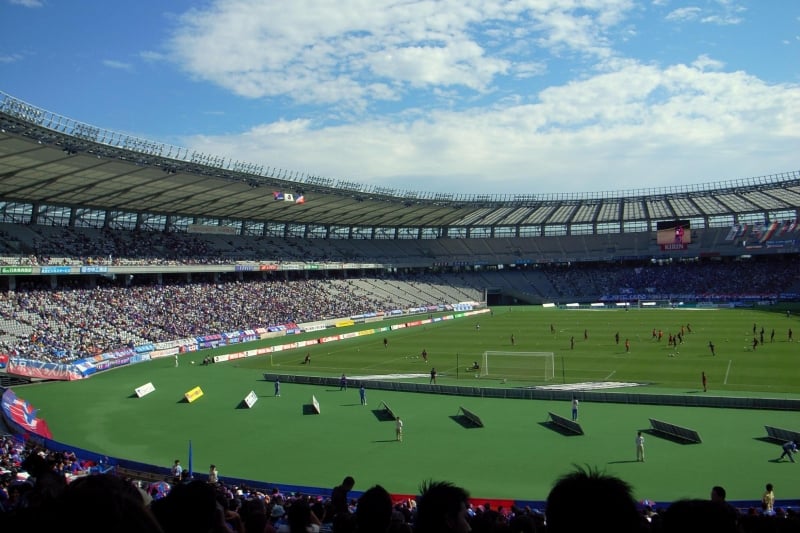
Image credit: yoppy
Stadium capacity: 49,970
Notable matches: Australia vs Wales, Sunday 29 September
How to get there: The closest transit stop is Tobitakyu Station, about 5 minutes walk from the stadium. It all depends which part of the country you’re coming from, but given the stadium’s location in the west of Tokyo, be sure to get on the Keio line.
Even though the Chofu district itself might not be a hotbed of tourist activity, there are still more than enough attractions within reach of the stadium to keep travellers occupied. There’s Yomiuri Land, a local theme park with some epic adrenaline-inducing rides and jaw-dropping light shows by night. Nature lovers will enjoy the tranquility of Showa Kinen Park. This 180-hectare botanical garden located in Tachikawa boasts a vast array of vivid flowers in full bloom. Sounds like Instagram heaven!
5. International Stadium Yokohama (Nissan Stadium)
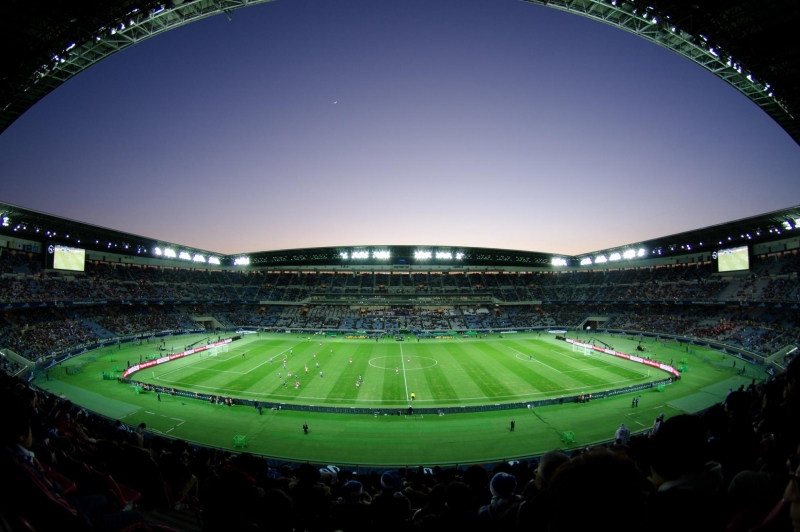
Image credit: Kanegen
Stadium capacity: 72,327
Notable matches: New Zealand vs South Africa, Saturday 21 September
How to get there: At only 35km from Tokyo, a trip to the Yokohama Stadium will take approximately an hour via regular train. The nearest station to the stadium is Kozukue Station, a 7-minute walk away from the colossal sporting venue.
The International Stadium Yokohama is the granddaddy of all the hosting stadia, with the largest capacity at a shade over 72,000 seats. It will see some epic matches (including the final) played during the course of the tournament. As far as identity goes, Yokohama sits somewhat in the shadow of Tokyo, close enough to be considered a district of the sprawling capital but with a more relaxed and peaceful atmosphere.
Visitors to the Rugby World Cup games are in for a treat, as activities abound in this region. Sights like Yamashita Park, Osanbashi Pier, Chinatown and Marine and Walk are all must-sees in-between rugby matches. Foodies will adore the Shin-Yokohama Ramen Museum, while art buffs can meander around the Yokohama Museum of Art and admire some of Japan’s oldest crafts.
6. Shizuoka Stadium Ecopa
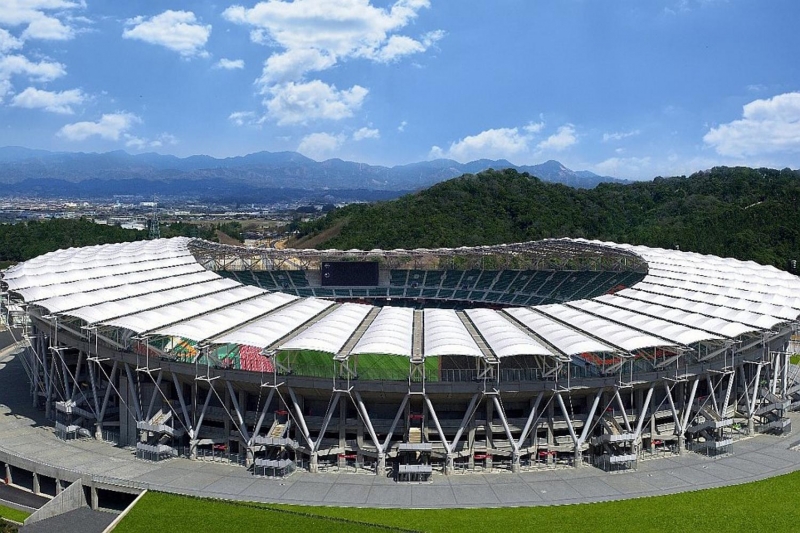
Image credit: Rugby World Cup
Stadium capacity: 50,889
Notable matches: Japan vs Ireland, Saturday 28 September
How to get there: The stadium sits just shy of two hours from Tokyo, accessible via the Tokaido Sanyo Kodama Shinkansen and JR Tokaido Main Line. JR Aino Station is the closest rail stop to the Ecopa Stadium, approximately 15 minutes away on foot.
This part of Japan is dominated by one of the country’s most iconic natural attractions; Mount Fuji. Some of the best vantage points are all within reach of Shizuoka City, but it’s not just about this 3776-metre dormant volcano. There’s also a gorgeous stretch of coastline along the Izu Peninsula, with Miho-no-Matsubara offering sublime views that include Mount Fuji. In addition, there are two beautifully restored relics in the form of the Hammatsu and Kakegawa Castles, nestled in the west of the province. Both these attractions are accessible from the stadium by train.
7. City of Toyota Stadium
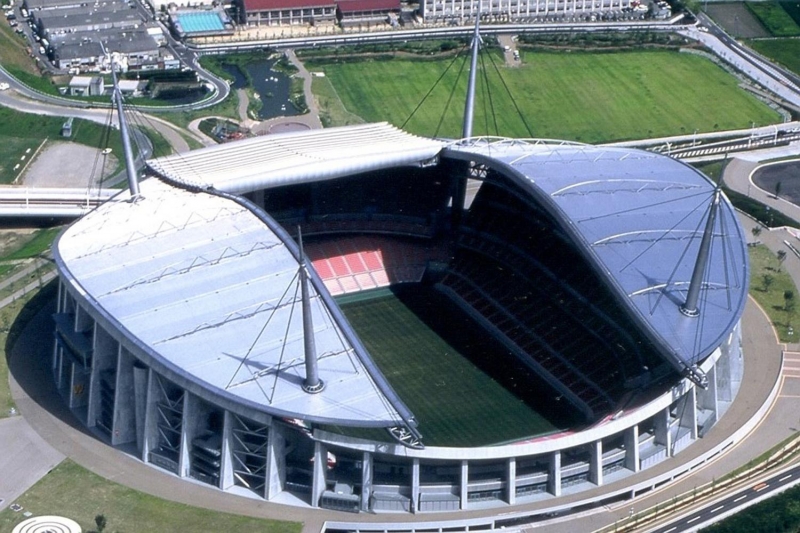
Image credit: Rugby World Cup
Stadium capacity: 45,000
Notable matches: Japan vs Samoa, Saturday 5 October
How to get there: The easiest way to get to the City of Toyota Stadium from both Osaka and Tokyo involves getting to Nagoya on the Tokaido Sanyo Shinkansen, changing to the Meitetsu Nagoya line, and then the Mikawa Line. The station closest to the stadium is Toyotashi Station, set about 15 minutes away by foot.
Despite being the birthplace of (arguably) Japan’s most well-known automotive brand, Toyota City has always ceded some of its influence to its nearby neighbour, Nagoya. Notwithstanding, there’s still a fair amount to do and see in the second-largest city within the Aichi Prefecture. Petrolheads will enjoy the Toyota Kaikan Museum, a sprawling facility where you can learn all about Toyota history, the manufacturing process and even witness a car roll fresh off the assembly line.
If you’re more into art than automobiles then the Toyota Municipal Museum of Art comes highly recommend – a tranquil, minimalist space with an emphasis on modern art. What if you’re a foodie and you fancy making some miso? Put Masuzuka Miso on your Toyota sightseeing list and learn how to make this delicious Japanese delicacy.
Kansai and Kyushu
8. Kobe Misaki Stadium (Noevir Stadium Kobe)
Stadium capacity: 30,132
Notable matches: England vs USA, Thursday 26 September
How to get there: Kobe Misaki Stadium is accessible from Misaki Koen Station, a 5-minute walk away. You can get there from both Osaka and Tokyo using the Tokaido Sanyo Main Line, getting off at Kobe Station and then taking a short 6-minute stretch from Harborland Station to Misaki koen Station.
The city of Kobe is renowned for its delectable seafood and charming sea views from the expansive port. Himeji Castle, however, is the showpiece tourist attraction – 400-year-old castle and UNESCO World Cultural Heritage Site which embodies everything there is to admire about feudal Japanese architecture.
9. Hanazono Rugby Stadium
Stadium capacity: 30,000
Notable matches: Georgia vs Fiji, Thursday 3 October
How to get there: Be sure to stop at the Higashi-Hanazono Station on the Kintetsu Nara Line for quick access to the stadium – approximately 10 minutes walk.
Set in East Osaka, the Hanazono Stadium will see its fair share of Rugby World Cup action along with its neighbour, Kobe Misaki Stadium, with 4 pool matches each to be played at the respective venues. As the oldest rugby ground in the country, this venue has been dubbed ‘the sacred ground of Japanese rugby’.
As far as attractions go, you’re spoilt for choice. You could either mission in to the bustling districts of Namba, Shinsaibashi or Umeda, or take it easy in the east. Here, you’ll find stunning views from Mount Ikoma, epic thrills at Hirakata Amusement Park and a dash of Japan’s industrial history at Konosuke Matsushita Museum.
10. Kumamoto Stadium (Umakana Yokana Stadium)
Stadium capacity: 32,000
Notable matches: Wales vs Uruguay, Sunday 13 October
How to get there: The easiest way to get to Kumamoto Stadium is using the shuttles which run from the Fanzone. But to get to the Fanzone, you’ll need to catch a bus which runs from JR Kumamoto Station, taking approximately 10 minutes.
Home to 650,000 residents, Kumamoto is a medium-sized city on the scenic island of Kyushu, around 40 minutes south of Fukuoka. It’s home to one of the country’s largest castles in Kumamoto Castle and although it isn’t open to the public following earthquake damage in 2016, you can see it from a viewing platform. If this doesn’t grab you then perhaps Mount Aso will. This active volcano has a colossal caldera measuring 25km in diameter and is accessible up to the crater of the rim – conditions permitting.
11. Oita Stadium (Oita Bank Dome)
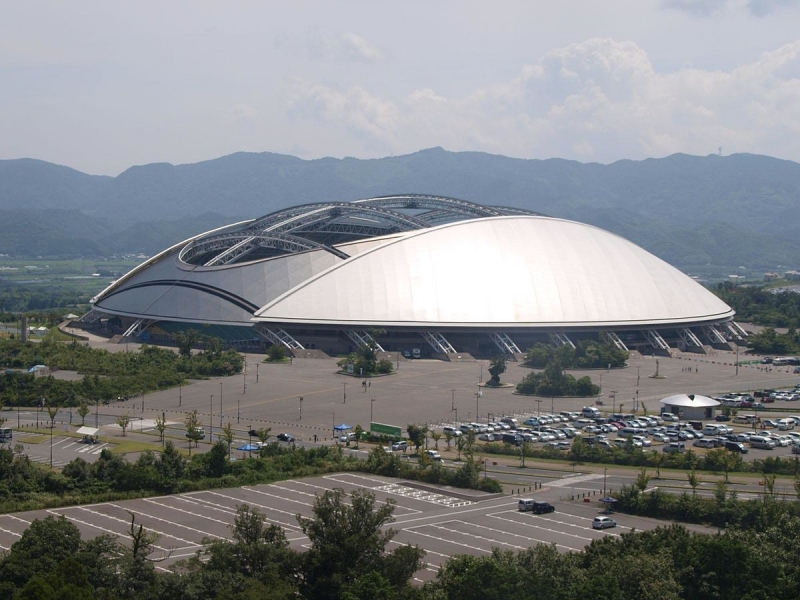
Image credit: 大分帰省中
Stadium capacity: 40,000
Notable matches: Wales v Fiji, Wednesday 09 October
How to get there: Oita Stadium will be serviced by shuttle busses from Oita Station for the duration of the Rugby World Cup, so don’t fret too much if you can’t find any regular public transport available. As for getting there from the rest of the country, your best bet if coming from either Tokyo or Osaka is a flight into the local Oita Airport. From the other cities in Kyushu, you’ll be best served by bus, with Fukuoka and Kumamoto no more than 2 hours away by highway bus. There is also an express train which runs from Fukuoka to Oita, for JR pass users in this region.
Oita’s slice of Rugby World Cup action includes three pool matches and two knock-out matches, making this a venue with lots going on. Outside of the oval-ball activities, you should definitely check out the onsen in neighbouring Beppu, a wellspring (pun intended) of relaxation. Because Japan is built on such a volcanic land, Beppu has the highest concentration of hot springs. The water here bubbles up to the surface at all sorts of extreme temperatures, giving you choices of steam baths, mud baths or even sand baths. If hot springs aren’t your scene then tick another castle off your list at Saiki Castle, dating back to 1606. Although large parts of it have been rebuilt, the remaining ruins that sit atop a mountain make it quite an impressive sight.
12. Fukuoka Hakatanomori Stadium (Level 5 Stadium)
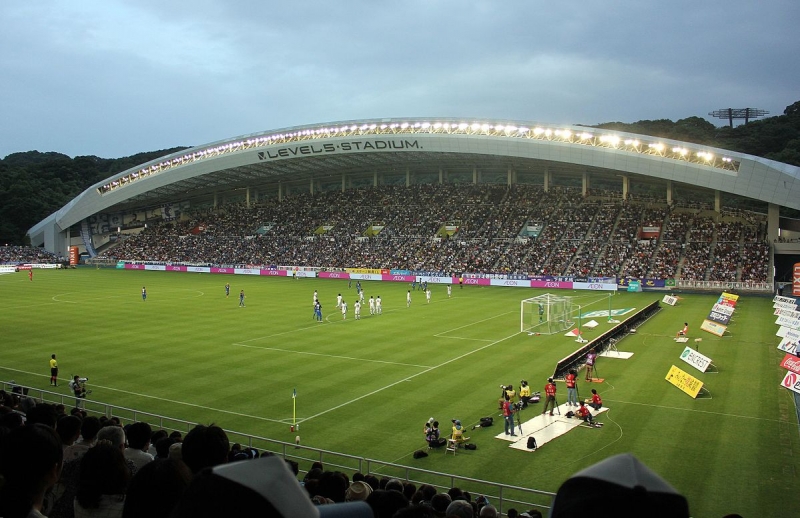
Image credit: Waka77
Stadium capacity: 22,563
Notable matches: France vs USA, Wednesday 2 October
How to get there: Stop off at either AEON Mall Fukuoka or No3. Umm Eigyosho, both 5 minutes by foot to Fukuoka Hakatanomori Stadium. Walking from the airport is also an option, as the stadium only sits 2km away – a great option for travellers flying in and out from other parts of the country or Asia.
Fukuoka Tower should be first on your list of sights here, serving up sweeping views of this unassuming Japanese metropolis. Shrines, however, rule the roost here, with the Atago Shrine, Kushida Shrine and Dazaifu Tenmangu all ranking highly on travel lists. If your team has just lost and you need some time to reflect, stroll around Ohori Park, a picturesque hideout in central Fukuoka, built in a classic Chinese style with a lake and islands connected to the mainland.
See You in Japan!
The 2019 Rugby World Cup promises to serve up some epic sporting action, and travellers will no doubt be in for a treat both on and off the pitch. No matter which team you’re backing to lift the William Webb Ellis trophy, you’re bound to be enchanted with everything that Japan has to offer.





